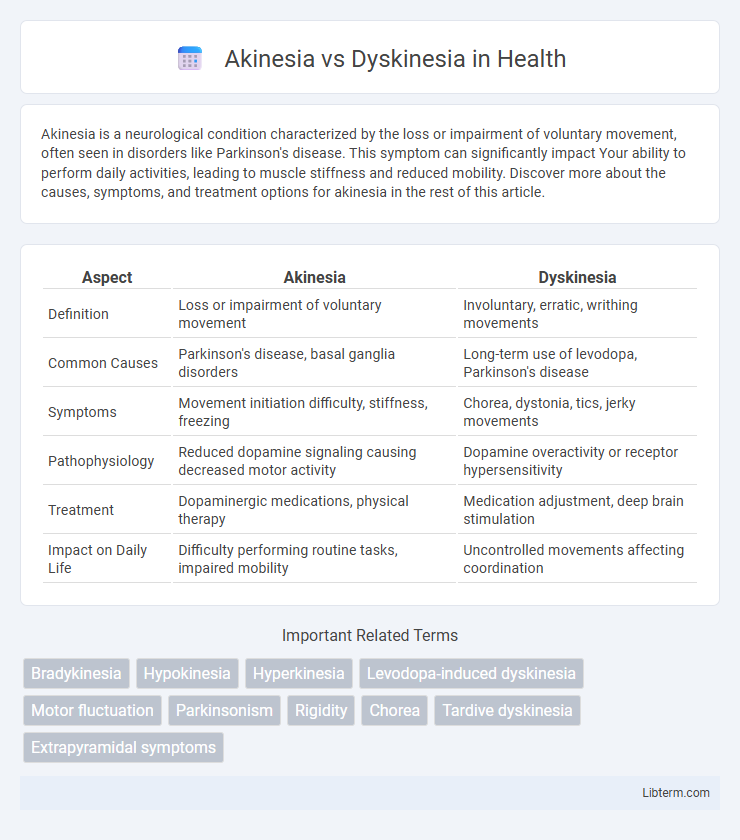Akinesia is a neurological condition characterized by the loss or impairment of voluntary movement, often seen in disorders like Parkinson's disease. This symptom can significantly impact Your ability to perform daily activities, leading to muscle stiffness and reduced mobility. Discover more about the causes, symptoms, and treatment options for akinesia in the rest of this article.
Table of Comparison
| Aspect | Akinesia | Dyskinesia |
|---|---|---|
| Definition | Loss or impairment of voluntary movement | Involuntary, erratic, writhing movements |
| Common Causes | Parkinson's disease, basal ganglia disorders | Long-term use of levodopa, Parkinson's disease |
| Symptoms | Movement initiation difficulty, stiffness, freezing | Chorea, dystonia, tics, jerky movements |
| Pathophysiology | Reduced dopamine signaling causing decreased motor activity | Dopamine overactivity or receptor hypersensitivity |
| Treatment | Dopaminergic medications, physical therapy | Medication adjustment, deep brain stimulation |
| Impact on Daily Life | Difficulty performing routine tasks, impaired mobility | Uncontrolled movements affecting coordination |
Understanding Akinesia and Dyskinesia
Akinesia refers to the loss or impairment of voluntary movement, often seen in Parkinson's disease as difficulty initiating motion, while dyskinesia involves involuntary, erratic, and excessive movements typically induced by long-term use of levodopa. Differentiating akinesia and dyskinesia is crucial for optimizing Parkinson's treatment strategies, as akinesia leads to motor freezing and rigidity, whereas dyskinesia results in uncontrollable choreic or dystonic movements. Understanding the pathophysiology and clinical presentation of both conditions aids in adjusting dopaminergic therapy to balance symptom control and minimize side effects.
Definition of Akinesia
Akinesia is characterized by the inability to initiate voluntary movement, often observed as a symptom in Parkinson's disease and other neurological disorders affecting motor control. It results from impaired function in the basal ganglia, leading to reduced dopamine transmission and difficulty in starting motion. In contrast, dyskinesia involves involuntary, erratic movements typically caused by long-term use of dopamine replacement therapies.
Definition of Dyskinesia
Dyskinesia refers to involuntary, erratic, and often excessive movements commonly associated with long-term use of dopaminergic medications in Parkinson's disease patients. These abnormal movements can manifest as chorea, dystonia, or myoclonus, severely impacting motor control and quality of life. Unlike akinesia, which involves loss or reduction of voluntary movement, dyskinesia represents hyperkinetic motor dysfunction linked to therapeutic side effects.
Key Differences Between Akinesia and Dyskinesia
Akinesia refers to the significant reduction or complete inability to initiate voluntary muscle movements, commonly observed in Parkinson's disease, while dyskinesia involves involuntary, erratic, and often excessive movements typically caused by long-term use of levodopa medication. Akinesia manifests as muscle rigidity and freezing episodes, whereas dyskinesia presents as choreiform or dystonic movements that can impair motor function. Understanding these key differences aids in accurate diagnosis and tailored treatment strategies for movement disorder patients.
Causes of Akinesia
Akinesia, characterized by an inability to initiate movement, primarily results from dysfunction in the basal ganglia, particularly the degeneration of dopaminergic neurons in the substantia nigra seen in Parkinson's disease. This loss of dopamine disrupts the normal signaling pathways essential for motor control, leading to bradykinesia and rigidity. Other causes include drug-induced parkinsonism from dopamine antagonist medications and certain neurodegenerative disorders affecting the motor circuits.
Causes of Dyskinesia
Dyskinesia primarily results from long-term use of dopamine replacement therapies, especially levodopa, in Parkinson's disease patients, causing abnormal involuntary movements due to fluctuating dopamine levels in the brain. The underlying cause involves sensitization and dysregulation of dopamine receptors in the basal ganglia, leading to excessive motor activity. Genetic factors and disease progression further contribute to the severity and onset of dyskinesia symptoms.
Symptoms and Clinical Manifestations
Akinesia is characterized by a marked reduction in voluntary movement initiation, resulting in slow or absent motion, often observed as difficulty in starting tasks or lack of facial expression (masked facies). Dyskinesia presents with involuntary, erratic, and often writhing movements, frequently involving the limbs, trunk, or face, and is commonly induced as a side effect of long-term dopaminergic therapy in Parkinson's disease. Clinically, patients with akinesia exhibit rigidity and bradykinesia, whereas those with dyskinesia experience uncontrollable, hyperkinetic motor activity that disrupts normal motor functions.
Diagnosis and Assessment
Akinesia is diagnosed through clinical observation of reduced voluntary movement and confirmed by motor function tests such as the Unified Parkinson's Disease Rating Scale (UPDRS). Dyskinesia is assessed using standardized scales like the Abnormal Involuntary Movement Scale (AIMS) to quantify involuntary, erratic movements commonly linked to long-term dopaminergic therapy. Neuroimaging and patient history further aid differential diagnosis by distinguishing bradykinesia-related rigidity from hyperkinetic dyskinetic manifestations.
Treatment Options and Management Strategies
Treatment options for akinesia primarily focus on enhancing dopamine levels using medications like levodopa or dopamine agonists to improve movement initiation, while dyskinesia management involves adjusting these medications to reduce involuntary movements, often incorporating amantadine or deep brain stimulation (DBS). Physical and occupational therapies are crucial for both conditions to maintain mobility, balance, and daily function. Continuous monitoring and personalized treatment plans by neurologists optimize symptom control and quality of life for patients experiencing either akinesia or dyskinesia.
Prognosis and Patient Quality of Life
Akinesia, characterized by the loss or impairment of voluntary movement, often results in significant motor disability and decreased independence, severely impacting patient quality of life due to mobility challenges and increased risk of falls. Dyskinesia, marked by involuntary, erratic movements typically arising from long-term Parkinson's disease treatment, can fluctuate unpredictably, complicating daily activities and causing social embarrassment or physical discomfort. Prognosis for akinesia often involves progressive motor decline with limited reversibility, whereas dyskinesia's trajectory depends on medication management, with optimized therapy potentially improving functional outcomes and enhancing patient well-being.
Akinesia Infographic

 libterm.com
libterm.com